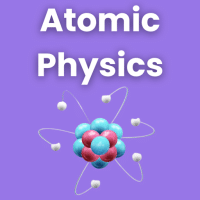GATE Physics Exam > GATE Physics Questions > If Ĥ and p respectively denote the Hamiltonia...
Start Learning for Free
If Ĥ and p respectively denote the Hamiltonian and the momentum operator for a free particle, then the functions sinkx and coskx are eigenfunctions
[HCU PHD 2010]
(a) of both Ĥ and p
(b) only of Ĥ but not of p
(c) only of p but not of Ĥ
(d) of neither Ĥ nor p?
[HCU PHD 2010]
(a) of both Ĥ and p
(b) only of Ĥ but not of p
(c) only of p but not of Ĥ
(d) of neither Ĥ nor p?
Most Upvoted Answer
If Ĥ and p respectively denote the Hamiltonian and the momentum operat...
Eigenfunctions of the Hamiltonian and Momentum Operator
When analyzing the functions sinkx and coskx in the context of quantum mechanics, we must consider their relationship with the Hamiltonian (Ĥ) and the momentum operator (p) for a free particle.
1. Hamiltonian Operator (Ĥ)
- The Hamiltonian for a free particle is given by:
Ĥ = - (ħ²/2m) (d²/dx²), where m is the mass of the particle.
- The functions sinkx and coskx are solutions to the time-independent Schrödinger equation associated with this Hamiltonian.
- Therefore, both sinkx and coskx are eigenfunctions of Ĥ, corresponding to specific energy eigenvalues.
2. Momentum Operator (p)
- The momentum operator is defined as:
p = -iħ (d/dx).
- To determine whether sinkx and coskx are eigenfunctions of p, we apply the momentum operator to these functions.
3. Application of the Momentum Operator
- For sinkx:
p(sinkx) = -iħ (d/dx)(sinkx) = -iħ(k coskx), which is not proportional to sinkx.
- For coskx:
p(coskx) = -iħ (d/dx)(coskx) = iħ(k sinkx), which is not proportional to coskx.
Conclusion
- Both sinkx and coskx are eigenfunctions of the Hamiltonian (Ĥ) but not of the momentum operator (p).
- Thus, the correct answer is (b) only of Ĥ but not of p.
When analyzing the functions sinkx and coskx in the context of quantum mechanics, we must consider their relationship with the Hamiltonian (Ĥ) and the momentum operator (p) for a free particle.
1. Hamiltonian Operator (Ĥ)
- The Hamiltonian for a free particle is given by:
Ĥ = - (ħ²/2m) (d²/dx²), where m is the mass of the particle.
- The functions sinkx and coskx are solutions to the time-independent Schrödinger equation associated with this Hamiltonian.
- Therefore, both sinkx and coskx are eigenfunctions of Ĥ, corresponding to specific energy eigenvalues.
2. Momentum Operator (p)
- The momentum operator is defined as:
p = -iħ (d/dx).
- To determine whether sinkx and coskx are eigenfunctions of p, we apply the momentum operator to these functions.
3. Application of the Momentum Operator
- For sinkx:
p(sinkx) = -iħ (d/dx)(sinkx) = -iħ(k coskx), which is not proportional to sinkx.
- For coskx:
p(coskx) = -iħ (d/dx)(coskx) = iħ(k sinkx), which is not proportional to coskx.
Conclusion
- Both sinkx and coskx are eigenfunctions of the Hamiltonian (Ĥ) but not of the momentum operator (p).
- Thus, the correct answer is (b) only of Ĥ but not of p.

|
Explore Courses for GATE Physics exam
|

|
If Ĥ and p respectively denote the Hamiltonian and the momentum operator for a free particle, then the functions sinkx and coskx are eigenfunctions[HCU PHD 2010](a) of both Ĥ and p(b) only of Ĥ but not of p(c) only of p but not of Ĥ(d) of neither Ĥ nor p?
Question Description
If Ĥ and p respectively denote the Hamiltonian and the momentum operator for a free particle, then the functions sinkx and coskx are eigenfunctions[HCU PHD 2010](a) of both Ĥ and p(b) only of Ĥ but not of p(c) only of p but not of Ĥ(d) of neither Ĥ nor p? for GATE Physics 2025 is part of GATE Physics preparation. The Question and answers have been prepared according to the GATE Physics exam syllabus. Information about If Ĥ and p respectively denote the Hamiltonian and the momentum operator for a free particle, then the functions sinkx and coskx are eigenfunctions[HCU PHD 2010](a) of both Ĥ and p(b) only of Ĥ but not of p(c) only of p but not of Ĥ(d) of neither Ĥ nor p? covers all topics & solutions for GATE Physics 2025 Exam. Find important definitions, questions, meanings, examples, exercises and tests below for If Ĥ and p respectively denote the Hamiltonian and the momentum operator for a free particle, then the functions sinkx and coskx are eigenfunctions[HCU PHD 2010](a) of both Ĥ and p(b) only of Ĥ but not of p(c) only of p but not of Ĥ(d) of neither Ĥ nor p?.
If Ĥ and p respectively denote the Hamiltonian and the momentum operator for a free particle, then the functions sinkx and coskx are eigenfunctions[HCU PHD 2010](a) of both Ĥ and p(b) only of Ĥ but not of p(c) only of p but not of Ĥ(d) of neither Ĥ nor p? for GATE Physics 2025 is part of GATE Physics preparation. The Question and answers have been prepared according to the GATE Physics exam syllabus. Information about If Ĥ and p respectively denote the Hamiltonian and the momentum operator for a free particle, then the functions sinkx and coskx are eigenfunctions[HCU PHD 2010](a) of both Ĥ and p(b) only of Ĥ but not of p(c) only of p but not of Ĥ(d) of neither Ĥ nor p? covers all topics & solutions for GATE Physics 2025 Exam. Find important definitions, questions, meanings, examples, exercises and tests below for If Ĥ and p respectively denote the Hamiltonian and the momentum operator for a free particle, then the functions sinkx and coskx are eigenfunctions[HCU PHD 2010](a) of both Ĥ and p(b) only of Ĥ but not of p(c) only of p but not of Ĥ(d) of neither Ĥ nor p?.
Solutions for If Ĥ and p respectively denote the Hamiltonian and the momentum operator for a free particle, then the functions sinkx and coskx are eigenfunctions[HCU PHD 2010](a) of both Ĥ and p(b) only of Ĥ but not of p(c) only of p but not of Ĥ(d) of neither Ĥ nor p? in English & in Hindi are available as part of our courses for GATE Physics.
Download more important topics, notes, lectures and mock test series for GATE Physics Exam by signing up for free.
Here you can find the meaning of If Ĥ and p respectively denote the Hamiltonian and the momentum operator for a free particle, then the functions sinkx and coskx are eigenfunctions[HCU PHD 2010](a) of both Ĥ and p(b) only of Ĥ but not of p(c) only of p but not of Ĥ(d) of neither Ĥ nor p? defined & explained in the simplest way possible. Besides giving the explanation of
If Ĥ and p respectively denote the Hamiltonian and the momentum operator for a free particle, then the functions sinkx and coskx are eigenfunctions[HCU PHD 2010](a) of both Ĥ and p(b) only of Ĥ but not of p(c) only of p but not of Ĥ(d) of neither Ĥ nor p?, a detailed solution for If Ĥ and p respectively denote the Hamiltonian and the momentum operator for a free particle, then the functions sinkx and coskx are eigenfunctions[HCU PHD 2010](a) of both Ĥ and p(b) only of Ĥ but not of p(c) only of p but not of Ĥ(d) of neither Ĥ nor p? has been provided alongside types of If Ĥ and p respectively denote the Hamiltonian and the momentum operator for a free particle, then the functions sinkx and coskx are eigenfunctions[HCU PHD 2010](a) of both Ĥ and p(b) only of Ĥ but not of p(c) only of p but not of Ĥ(d) of neither Ĥ nor p? theory, EduRev gives you an
ample number of questions to practice If Ĥ and p respectively denote the Hamiltonian and the momentum operator for a free particle, then the functions sinkx and coskx are eigenfunctions[HCU PHD 2010](a) of both Ĥ and p(b) only of Ĥ but not of p(c) only of p but not of Ĥ(d) of neither Ĥ nor p? tests, examples and also practice GATE Physics tests.

|
Explore Courses for GATE Physics exam
|

|
Signup for Free!
Signup to see your scores go up within 7 days! Learn & Practice with 1000+ FREE Notes, Videos & Tests.
























